Email newsletter is one of the best ways to generate revenue and build long-lasting relationships with customers and subscribers. As much as 60% of people say that they have made a purchase as a result of a promotional email from a brand.
That’s easy, automated sales.
Sadly, not all newsletters perform well.
An average professional individual receives up to 121 emails per day and 79% of consumers delete brand emails right away without opening them.
Keep reading to find out how to make sure your email doesn’t get this type of treatment. The following newsletter best practices will help you take email marketing to the next level.
What is a Newsletter?
It is an email communication that businesses (and individuals) use to share relevant information with their subscribers. A newsletter doesn’t have to be necessarily informative (as it’s commonly assumed by marketers), you can send any type of email and content in the newsletter including promotions, company news, updates, etc.
Here’s an example of a newsletter. It has a nice intro, new store update, new products, and tips with images:

Newsletters let you build relationships with your customers and subscribers. You can keep them hooked and convert subscribers into customers by keeping them engaged.
Importantly, newsletters help you generate sales by offering discounts to existing customers. It significantly increases repeat purchases leading to a high AOV and customer lifetime value.
On average, businesses earn up to $72 for every $1 spent on email marketing. That’s a massive ROI and a reason why you should set up your newsletter campaign.
Newsletter Best Practices for Higher Engagement
Here’s a list of the best practices you should follow to run a successful newsletter campaign:
1. Use Friendly, Known Email Address
The first thing that your subscribers see is the sender’s email address. It turns out to be a dealbreaker. An email from a friendly, known, and non-spammy sender is more likely to be opened.
You should use a business email and a name that your subscribers are familiar with. For example, if you have a brand and your audience recognizes you as a brand, use your brand name to send emails. If subscribers know you as an individual, use your personal business email address.
Research shows that emails sent from a generic email address like Gmail or Yahoo negatively impact engagement and open rate. Some 33% of people say that they don’t trust emails from generic email addresses:

MailChimp recommends using a corporate email address for newsletters as it ensures security, consistency, trust, branding, and offers several other benefits:

You also need to follow CAN-SPAM guidelines that clearly indicate that businesses shouldn’t use No Reply or similar words in the sender’s email address.
So, you shouldn’t use No Reply, generic email providers, and personal names (unless you are the brand yourself) in the sender’s email address. Use a proper business email address that your audience is familiar with as it will significantly boost email open rate.
2. Optimize Subject Line
The first thing subscribers see in an email newsletter is its subject line. As much as 64% of people open emails based on subject lines and 69% of recipients mark emails spam based on subject lines:

Subject line impacts email open rate which means a poor subject line means your email will never be opened and would ultimately have zero engagement. Writing catchy subject lines is tricky and requires a lot of testing (as there isn’t any standard).
This is a reason why 47% of marketers regularly test subject lines for optimization. The experimentation feature is offered by all the leading email marketing platforms (more on this later).
Follow these guidelines to write compelling and persuasive subject lines:
- Avoid spam trigger words that alert email providers and your email is marked spam automatically. One in every five emails are caught by spam filters and that’s something you can avoid by not using certain words in the subject line. Check out this list of spam trigger words and don’t use any of these in subject lines.
- Keep the subject line short. Ideally, the subject line should have under 50 characters. Subject lines having 50 or fewer characters have a 12% higher open rate and 75% higher CTR.
- Use personalization in the subject line. Adding a recipient’s name is the most common yet successful way to improve newsletter open rate as it persuades recipients to click and open the email.
- The subject line should be descriptive and meaningful. It should communicate the content of the email. Incomplete or meaningless subject lines don’t grab attention and rather look spammy.
- Limit the use of emojis and punctuation in the newsletter subject line. Special characters might mark your email spam as they are spam triggers. The same is the case with emojis. You should use them smartly. Use a single emoji per subject line to keep it natural.
- Add a call to action in the subject line such as ‘open this for a free gift’ as opposed to ‘free gift inside’. CTA improves open rate as it tells recipients what action they have to take and it also generates curiosity.
Here are a few subject line examples with their open rates to help you get ideas:

Subject lines that offer high value such as discount and sales and are descriptive work best. Unclear subject lines tend to have low open rates comparatively.
3. Improve Preheader
A preheader in an email is the text that appears right after the subject line in the user’s inbox. This plays a critical role in newsletter open rate as it’s the first thing people read after the subject line.
Here’s an example of an email preheader:
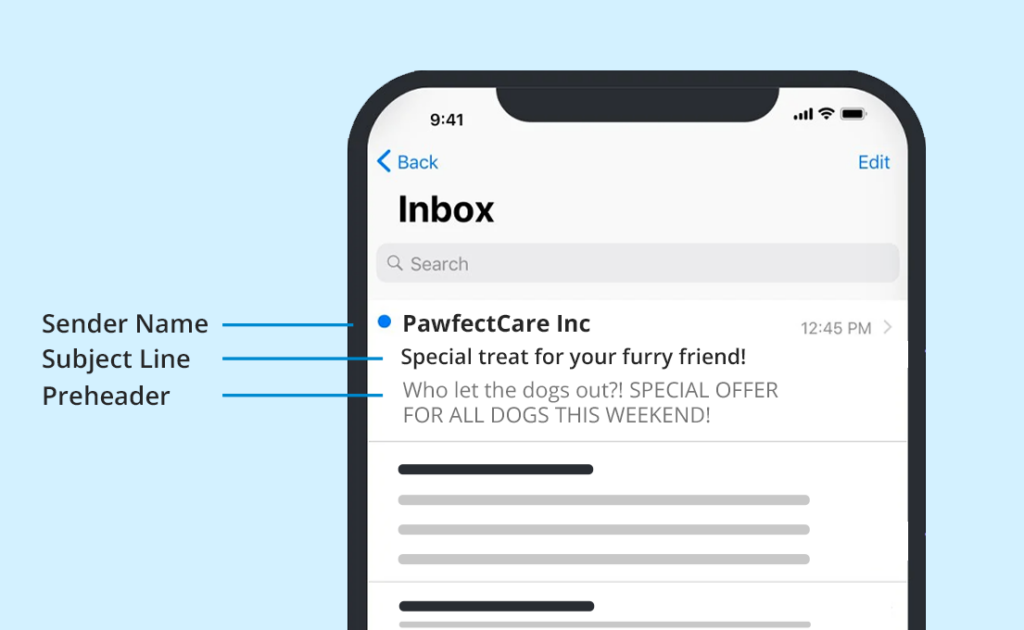
You should optimize it and make it catchy to ensure readers click and open your email and read it. Here’s an example of preheader text that works with the subject line:

Follow these newsletter best practices to write better preheaders:
- Keep it short. There isn’t a fixed limit but it’s good to have your preheader between 30 to 55 characters. Email providers can replace preheader text with newsletter content if it’s too short. So, make sure you use the right number of characters as recommended by your email marketing tool.
- Make it meaningful and descriptive. Use it to encourage readers to open your email. The best way is to provide a quick overview and extension of the subject line with a CTA.
- Preheader should be unique and doesn’t repeat the subject line. Rather, the preheader should work with the subject line by adding more details.
- A good preheader builds curiosity instead of simply adding a CTA. Develop interest by referring to the outcomes or incentives that the newsletter offers.
4. Move the Main Message and CTA Above the Fold
The subject line and preheader of your newsletter persuade recipients to open it, great.
The next step is to make sure the most important text is available instantly to the subscribers. That is, the primary CTA and main message should be placed above the fold so recipients have access to it without scrolling.
This is important because, on average, users spend up to 9 seconds looking at an email and in most cases, they don’t have the time or interest to scroll down. So, you have to capture their attention in 9 seconds or less.
Alternatively, you should offer everything above the fold so it’s instantly available. Even if they don’t scroll, you’ll have your message conveyed (which is the whole point of the newsletter campaign).
The above the fold area of an email, in general, is 250-400 pixels for desktops and 320-385 pixels for most mobile devices. This might vary from device to device, and your email marketing platform will better show you how to identify correct above the fold dimensions across devices. It is, however, not tool-dependent but rather device-dependent.

You need to utilize this section smartly. Here’s how:
- The main text or the offer should be placed above the fold
- Add your logo or brand name with a clear and persuasive CTA
- The content and offer should be consistent with the subject line and preheader text. All of them should work together collectively
- Add an image to capture the attention of the readers.
Preview your newsletter across all major devices before scheduling it. This will ensure that above the fold area is utilized properly and nothing is missed.
5. Personalize Your Newsletter
Personalization is a key component of newsletter success. The use of dynamic content in emails to boost personalization is the top tactic used by email marketers. Personalized newsletters have 29% higher unique open rates and 41% higher click rates than non-personalized emails.
Here’s an example of a personalized email that refers to the items in the cart with relevant image and discount code:
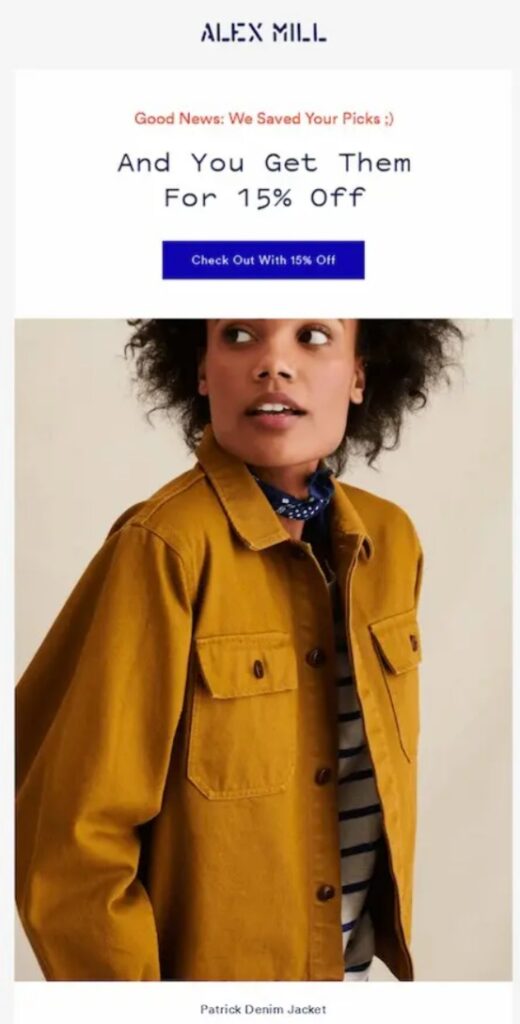
Dynamic content is the perfect way to customize newsletters as it helps change relevant content across email segments automatically. Here’s how Nordstrom uses dynamic content to match subscriber’s location weather:

Here are the newsletter best practices to improve personalization and boost engagement:
- Collect the right data from your subscribers. For example, to send region-specific emails, you should have their location and this requires you to ask them to update preferences regularly.
- Use segmentation to put subscribers in the right list for automation and customization. More on segmentation in the next topic.
- Leverage dynamic content as much as possible as it’s the best and the easiest way to customize newsletter content.
- Use the recipient’s name in the greeting to grab attention instantly.
- Behavioral trigger emails such as welcome emails, cart abandonment emails, etc. are perfect examples of personalization. Keep using them to engage with your subscribers.
6. Segment Your Email List
Segmentation is a necessary component of email engagement. It helps you improve personalization by sending targeted emails to your segments. You can increase email marketing revenue by a whopping 760% by segmenting your email lists:

According to HubSpot, segmentation is the most effective marketing strategy as reported by 78% of marketers and such campaigns drive 30% more open and 50% more clicks than unsegmented email campaigns.
Here’s how list segmentation works:
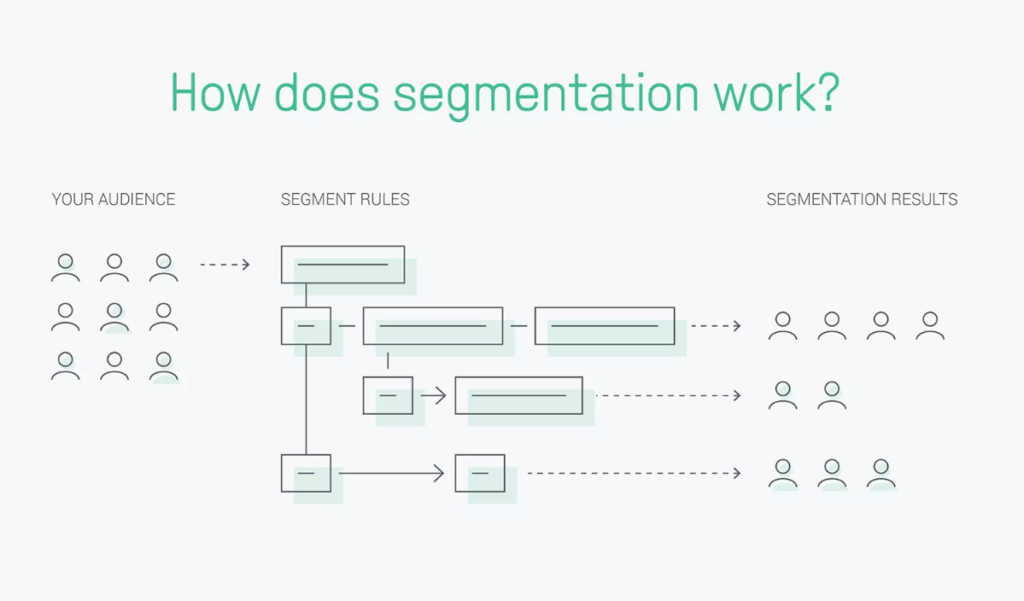
You need to define segment rules that move subscribers to relevant segments automatically. For example, subscribers who haven’t opened an email in the last 90 days should be moved to a separate list so you can re-engage them.
Similarly, you can move highly engaged subscribers to a new segment and offer them exclusive benefits and discounts based on their loyalty.
You can create unlimited segments based on a wide range of variables. The popular email segmentation ideas include:
- Demographic
- Geographic
- Engagement level
- Behavioral
- Loyalty
- Stage in the sales funnel
- Newsletter type
- Purchase history
- Survey response
- Customer support interaction
- Social media followers.
And so on…
Segmentation is a continuous and automated process. Subscribers move automatically among segments based on their engagement, data, and preference changes. These are created and managed automatically by your email marketing platform.
7. Clean Your Email List
How often do you clean your email lists?
It is the process of removing invalid and inactive email addresses from your list to improve the delivery rate, reduce spam, and cut cost.
Research shows that regularly cleaning your email lists decreases hard and soft bounce rates and reduces chances of getting your email marked spam:

This is a reason why up to 29% of email marketers clean their email lists on a monthly basis:

Email scrubbing doesn’t just improve newsletter performance and email deliverability, it helps you reduce email marketing cost.
Most email marketing platforms charge you on the number of subscribers you have. If you have a large email list, you’ll pay a high monthly fee as opposed to having a small email list.
Here’s an example:
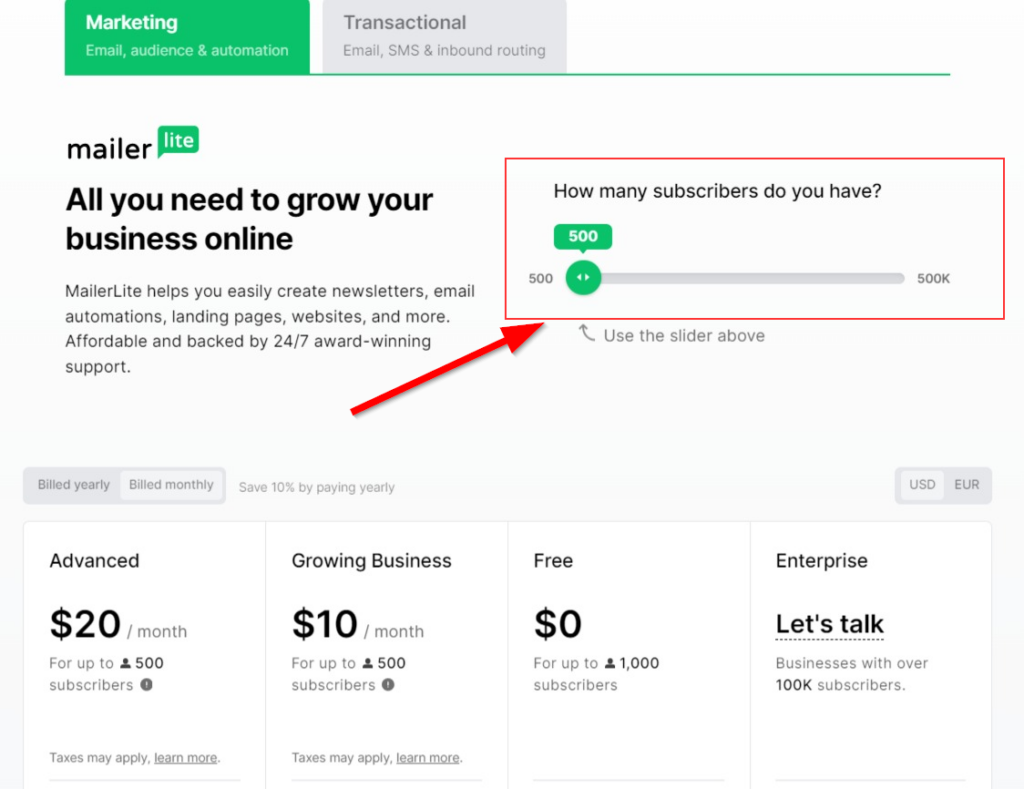
Email cleaning removes invalid email addresses and reduces monthly subscription costs by shrinking your list size.
Follow these tactics to clean your email list successfully without removing active subscribers:

- Remove inactive subscribers after you have engaged with them multiple times
- Get rid of the spam complaints and emails that bounce your emails
- Use double opt-in to filter email addresses right from start
- Run re-engagement campaigns before removing email addresses
- Add an unsubscribe link in all the emails so subscribers can leave when they want to. And make it easy for subscribers to get off your list at will
- Correct obvious typos and remove spammy email addresses.
8. Optimize Sending Time and Frequency
How often you send a newsletter and when you send it has a huge impact on engagement levels. Studies show that Tuesday is the best day of the week to send marketing emails between 9-12 AM EST:
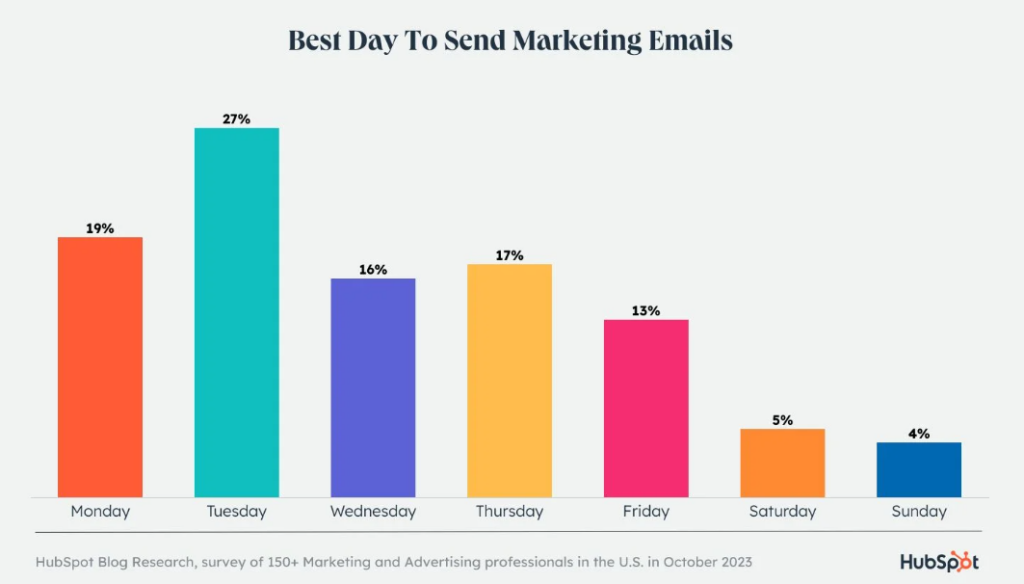
This is based on engagement levels and how people interact with emails throughout the day. For example, the Mailjet report shows that Tuesday has the highest email open rate and click-through rates:

The same goes for sending frequency. The number one reason why people unsubscribe from an email list is due to high email frequency. This is demonstrated by the HubSpot survey where most marketers (22%) send 2-3 emails per day while 21% of marketers send one email per day:

That’s too much.
Newsletters should be sent weekly or monthly. Importantly, you should stick with the frequency you promised during the signup.
For example, if your signup form says ‘subscribe for monthly newsletter’, you should send a newsletter once a month. If you promised a weekly newsletter, send it every week. That’s another reason why it’s important to segment your subscribers. You can add subscribers to relevant groups and send them newsletters at the right frequency (as promised) instead of sending a single newsletter to your entire list.
Email sending frequency and timing are important for high engagement. The best way to figure out optimal timing and frequency is by asking your subscribers through a survey and looking at the analytics.
Use data to analyze email campaigns and find out what days, timings, and frequency deliver the highest engagement. Stick with it and continue to optimize.
Remember, sending timing and frequency are relative and depend on multiple factors. There isn’t any standard best day or time. For instance, a news site will have a high frequency and it might send multiple emails in a single day to its subscribers based on breaking news and headlines.
On the other side, a B2B business might have to send a monthly newsletter to its clients.
Figure out what works best for your business.
9. Deliver Value
High-value emails that offer exclusive benefits, incentives, and other perks to subscribers have high engagement. If you send an RSS feed in your newsletter, you’ll most likely have a low open rate and significantly low CTR.
Most of your subscribers might have read articles on your blog already.
The number one reason why people subscribe to marketing emails is to get notified of sales and promotions followed by content updates by the brand:

Even if you are sending regular content updates, you should make it appealing and add more value. For example, you can create images and videos exclusively for your subscribers and let them get all the info without clicking any link.
Sending discounts and promotions is the best way to keep your subscribers hooked. That’s what they expect.
Here’s an example of a well-crafted and high-value email:

It is a customized and detailed email and the content isn’t scrapped from recent blog posts rather it is specifically crafted for the email.
That’s how you deliver exceptional content to engage your subscribers.
10. A/B Test
Experimentation and testing are essential for email marketing success. It is one of the best newsletter best practices out there.
A/B testing helps you optimize everything ranging from subject lines to preheader text to newsletter content to sending frequency and much more. It works by comparing two versions of an email to identify a winner. It is a scientific and data-driven approach to email marketing optimization:
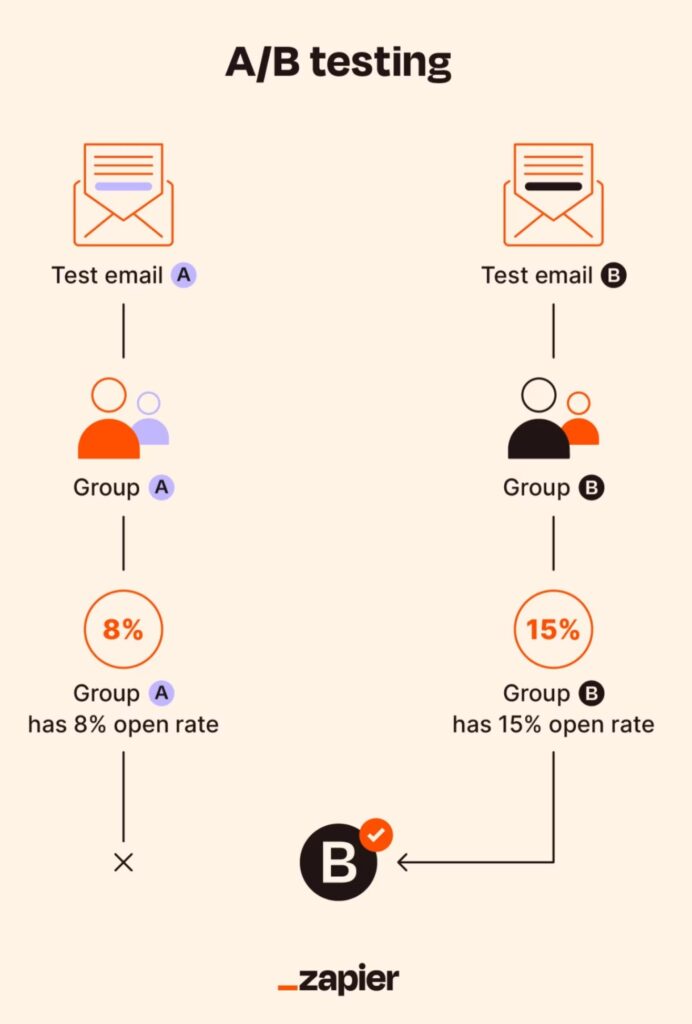
Research shows that A/B testing increases email ROI by 28% and up to 18% of marketers have successfully increased email clicks by A/B testing.
Testing the right variables that directly impact open and click rates is critical. You can essentially test anything that’s related to your newsletter campaign, but not everything is worth testing.
Here’s a list of the most critical variables to test:
- Sender name and email address
- Subject line
- Preheader text
- Email copy
- Call to actions
- Above the fold area
- Images and videos in the email body
- Email design and structure
- Types of email campaigns
- Sending time, day, and frequency.
Running an A/B test for newsletter optimization is quite easy as the testing feature is embedded within the email marketing tool. Almost all the popular email marketing platforms offer A/B testing features.
Here’s an example from Mailer Lite:
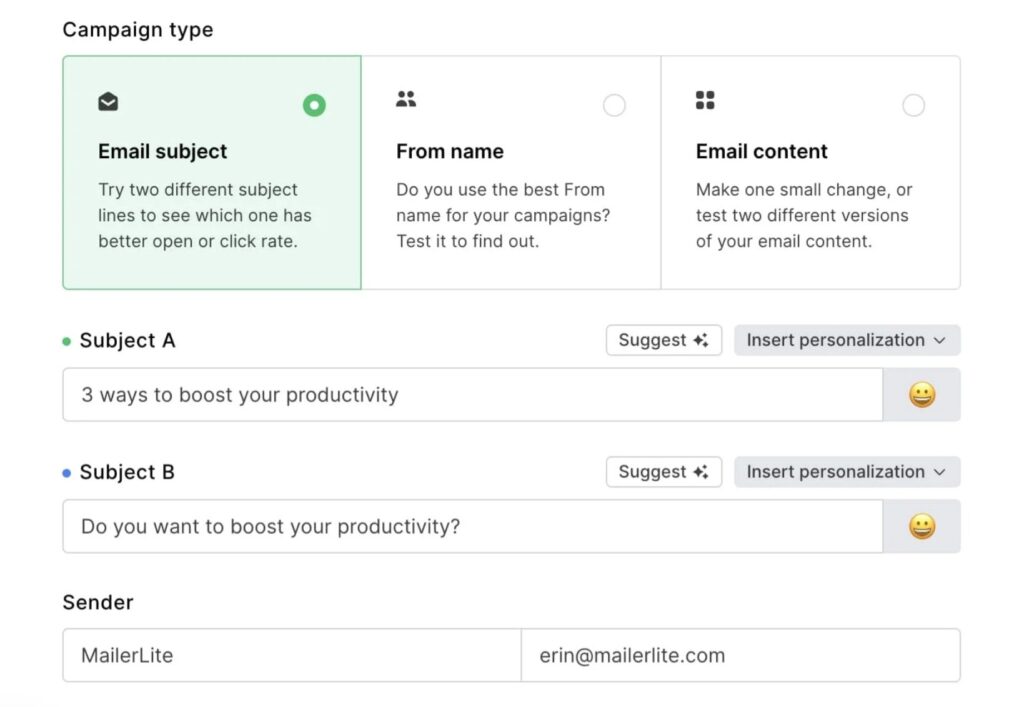
You have to select relevant variables, add details, and the test is managed by the tool for you.
Email testing is a continuous process (like any other form of A/B testing) where you have to keep testing different elements of your email to improve engagement.
Conclusion
These email newsletter best practices will help you drive huge success and grow your business. The techniques, tips, and tactics discussed in this article need iterations and A/B testing.
You have to understand that best practice doesn’t mean you can copy-paste it and expect wonders.
No.
Rather you need to test these based on your audience and business and see what works best for you. Tweak these tactics based on data and continue testing and improving your newsletter campaigns.
Data collection, analysis, and testing are essential elements for email marketing success. Hold them tightly.
Featured Image: Unsplash



